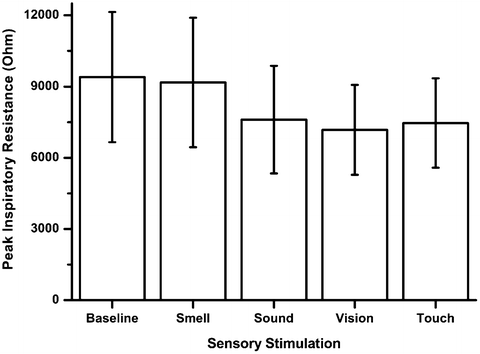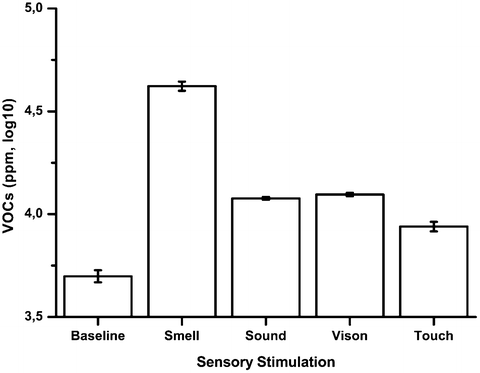Fig. 1
Breathing frequency during sensory stimulations

Fig. 2
Inspiratory resistance, taken as a surrogate of the volume component of respiratory pattern, during sensory stimulations

Fig. 3
Real-time exhaled volatile organic compounds (VOCs) during sensory stimulations. Stimulation of each sensory system significantly enhanced VOCs compared with the baseline level (p < 0.001)
4 Discussion
In the present study we investigated whether sensory stimulation could affect the content of VOCs in exhaled breath on the premise that the VOCs content could reflect variations in neuronal metabolism altered through transmission of sensory receptors activity to the perceptive brain areas. We found a significant increase in the total amount of VOCs exhaled during sensory stimulation. In particular, the olfactory stimulation was much effective in increasing VOCs. That effect could result from the geometry of olfactory neural circuitry which does not pass through the thalamus, but rather projects straight to the limbic system, which is contrast to the other sensory modalities investigated in the present study. The variations in exhaled VOCs content we recorded could not be confounded by altered breathing pattern, since the sensory stimulations were short in time so much that they failed to affect the breathing pattern.
In recent studies, investigation of exhaled VOCs has been applied to neurodegenerative diseases and cognitive disturbances in diabetes type 2, which highlights that these compounds vary in concentration and fingerprint in a range of pathological conditions (Ionescu et al. 2011; Tisch et al. 2013; Mazzatenta et al. 2013c, 2015b). However, the unanswered question remained of whether VOCs content could also be influenced due to activation of neuronal metabolism during peripheral sensory stimulation in healthy subjects. The present investigation provided a confirmatory answer to that issue. These findings broaden our knowledge of the link between neural metabolism and exhaled VOCs alterations. The study also highlights the olfactory function as being notably sensitive and influential in producing VOCs alterations in exhaled breath.
< div class='tao-gold-member'>
Only gold members can continue reading. Log In or Register to continue
Stay updated, free articles. Join our Telegram channel

Full access? Get Clinical Tree


